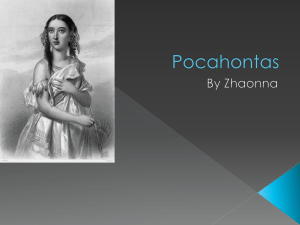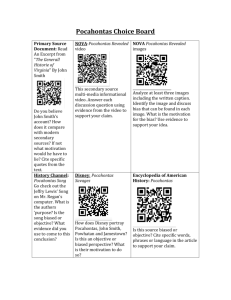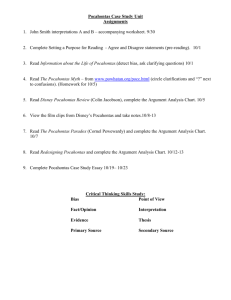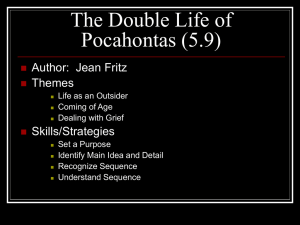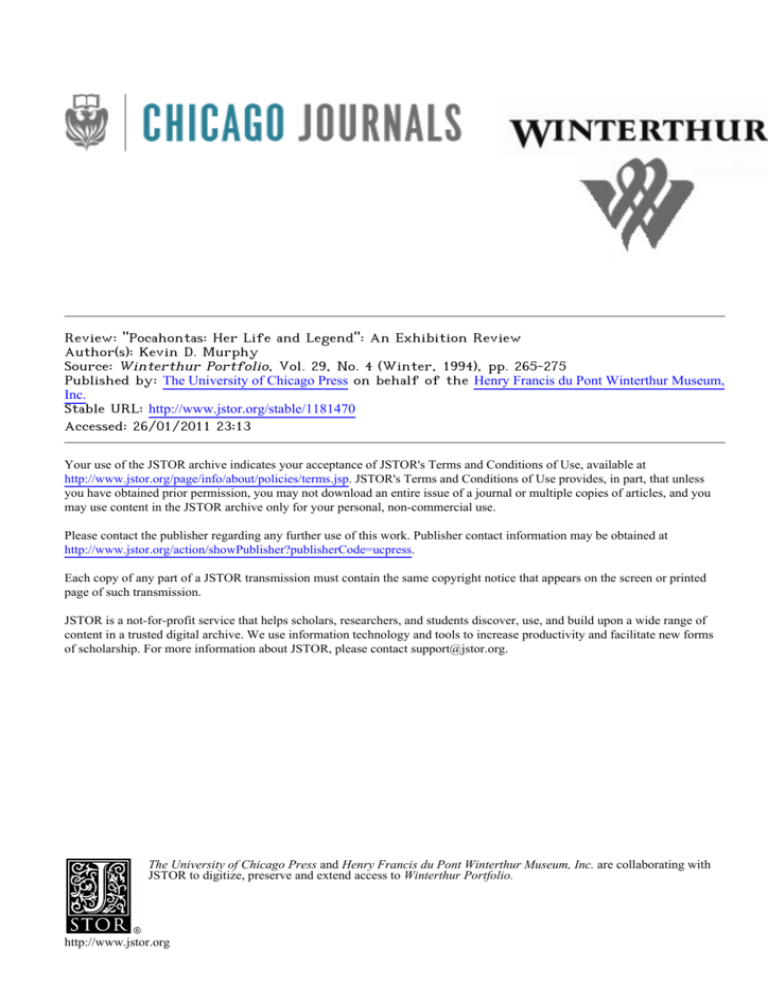
Review: "Pocahontas: Her Life and Legend": An Exhibition Review
Author(s): Kevin D. Murphy
Source: Winterthur Portfolio, Vol. 29, No. 4 (Winter, 1994), pp. 265-275
Published by: The University of Chicago Press on behalf of the Henry Francis du Pont Winterthur Museum,
Inc.
Stable URL: http://www.jstor.org/stable/1181470 .
Accessed: 26/01/2011 23:13
Your use of the JSTOR archive indicates your acceptance of JSTOR's Terms and Conditions of Use, available at .
http://www.jstor.org/page/info/about/policies/terms.jsp. JSTOR's Terms and Conditions of Use provides, in part, that unless
you have obtained prior permission, you may not download an entire issue of a journal or multiple copies of articles, and you
may use content in the JSTOR archive only for your personal, non-commercial use.
Please contact the publisher regarding any further use of this work. Publisher contact information may be obtained at .
http://www.jstor.org/action/showPublisher?publisherCode=ucpress. .
Each copy of any part of a JSTOR transmission must contain the same copyright notice that appears on the screen or printed
page of such transmission.
JSTOR is a not-for-profit service that helps scholars, researchers, and students discover, use, and build upon a wide range of
content in a trusted digital archive. We use information technology and tools to increase productivity and facilitate new forms
of scholarship. For more information about JSTOR, please contact support@jstor.org.
The University of Chicago Press and Henry Francis du Pont Winterthur Museum, Inc. are collaborating with
JSTOR to digitize, preserve and extend access to Winterthur Portfolio.
http://www.jstor.org
"Pocahontas: Her
and
Life
Legend"
An Exhibition Review
Kevin D. Murphy
"Pocahontas: Her Life and Legend." Virginia Historical Society, Richmond. October 24, 1994 to
April 30, 1995.
William M. S. Rasmussen and Robert S. Tilton.
Pocahontas: Her Life and Legend. Richmond: Virginia Historical Society, 1994. 56 pp.; 44 black and
white and color illustrations. $13.95.
With the exhibition "Pocahontas: Her Life and
Legend," the Virginia Historical Society attempts
to show its public how the image of this famous
figure has been used and manipulated over the
course of three centuries (fig. i). William M. S.
Rasmussen and Robert S. Tilton, the exhibition curators and authors of the accompanying publication, propose in the label text to "separate the historical figure from her legend" by examining in
the exhibition "the culture that produced Pocahontas, the half dozen episodes that make up her
story, and the Pocahontas of fantasy."' Anxious to
uncover the objective facts of the case, the curators
lament that the story of Pocahontas "has so often
been retold and embellished and so frequently
adapted to contemporary issues that the actual
flesh-and-blood woman has long been hidden by
the ever-burgeoning mythology." Despite this
Kevin D. Murphy is assistant professor in the Department
of Architectural History at the University of Virginia.
1 For the sake of
convenience, I describe the publication as
a catalogue, although it is not one in the strictest sense. While
the publication reproduces and in some cases further develops
the text of the exhibition, it does not document the works on
display.
? 1994 by The Henry Francis du Pont Winterthur Museum,
Inc. All rights reserved. 0084-0416/94/2904-0004$3.00
claim to an objective account in the introductory
panel, the viewer leaves the exhibition questioning
whether the supposed events of Pocahontas's life
actually took place. Indeed, the exhibition provocatively implies that the most renowned individuals
in United States history may be inseparable from
their representations in both "high" art and popular culture. While this idea would be generally acceptable to most historians, it is still controversial
to the larger public.
The Pocahontas exhibition represents a laudable attempt to integrate contemporary academic
concerns and public history. My analysis of the exhibition and its catalogue proceeds from a deep
sympathy with the project of bringing together academic history (as well as art history) and museum
practice. I believe, however, an even broader range
of existing scholarship might have been brought
to bear on the fascinating material addressed in
this exhibition.
The legend of Pocahontas has all the elements
to make it especially relevant to current historical
and art historical debates. A Powhatan Indian, Pocahontas allegedly intervened in a dispute between
the English and the Indians on behalf of Capt.
her father, the king, to
John Smith-imploring
spare the Englishman. The exhibition shows how
obsessively this scene has been worked over by artists who have often imagined an amorous attraction between the two figures to explain Pocahontas's meddling in this dispute between men.
Subsequently captured by the British, married to
John Rolfe, baptized "Rebecca" in the Christian
faith, and ultimately displayed throughout England (where she suddenly died in 1617), Pocahontas inspires a treatment of her life in terms of re-
WinterthurPortfolio 29:4
266
Fig. 1. Installation,"Pocahontas:Her Life and Legend," Virginia HistoricalSociety, Richmond, 1994-95.
cent scholarship on the issues of gender, sexuality,
and ethnicity. These themes indeed percolate
through the Pocahontas exhibition and catalogue,
but in avoiding polemics, the Virginia Historical
Society stops short of fully exploring some of the
provocative issues raised by the Pocahontas story.
The obvious (yet in the exhibition, unstated)
fact of the case at hand is that we only know about
Pocahontas through representations made by others who (with the exception of Smith) had no
first-hand knowledge of her and who were equally
ignorant of Powhatan culture. In her 1986 study,
Mary V. Dearborn makes the point succinctly, observing that "Pocahontas, . . . a favorite heroine
of American culture, has achieved that status only
through representations. The only means by which
her story can be told is by piecing together the
accounts of others, by studying interpretations of
her image in literature, history, and cultural iconography . . . Illiterate and unphotographed, Pocahontas left no authentic record of herself."2 This
exhibition, commemorating the 400th anniversary
of Pocahontas's birth, constitutes an attempt to
compile just such an array of representations.
The implication made by the representations
amassed in the exhibition is that all the images,
whether literary or visual, occupy a similar position
in our culture. All the works on display at the Virginia Historical Society contribute to the mythologizing of Pocahontas, but they do so in vastly different ways. The exhibition includes large-scale oil
2
Mary V. Dearborn, Pocahontas'sDaughters: Genderand Ethnicity in American Culture (Oxford, Eng.: Oxford University
Press, 1986), p. 12. Although the claim made here for the inherent "authenticity" of self-representation and photography
could be challenged, the larger point is well made.
Pocahontas
267
Fig. 2. Henry Brueckner, The Marriage of Pocahontas, 1855. Oil on canvas; H. 50", W. 70". (New York State Office
of General Services, New York State Executive Mansion, Albany.)
paintings, reproductions of murals, a video recording of a television program, audio recordings of
popular songs, prints, plates, and other products
of material culture. In some cases the exhibition
and catalogue compellingly address the relationship between such elite media as oil painting and
more popular forms of representation. For instance, a number of depictions of the wedding of
Pocahontas to Rolfe are discussed, including
Henry Brueckner's large-scale 1855 painting,
which served as the basis for a later engraving
(fig. 2). The authors tell us that "the print was engraved by John McRae and published by Joseph
Laing, who at mid-century began distributing
large-scale prints out of his shops in New York,
London, and Edinburgh. Laing produced engravings of a number of history paintings, including
the four new murals in the United States Capitol,
one of which was [John Gadsby] Chapman's Baptism of Pocahontas [1836-40]" (p. 27). Thus images
of Pocahontas circulated in complex ways through
various media in the nineteenth century.
Often, however, the exhibition and catalogue
fail to distinguish between the audiences for different media; the roles of producer and consumer of
the Pocahontas legend are inadequately treated.
In many instances, scant information is provided
about the producers of the works, to the extent
that there is little sense of how they came to depict
Pocahontas or how the work displayed in the exhibition compares to the rest of their output. Further, the catalogue does not contain a list of objects
on display and thereby suggests that the works
themselves, as material artifacts, are of less concern
than the motifs they represent.
In some cases, the circumstances under which
the works were originally displayed seem important and intriguing and, if discussed at greater
length, might have helped the visitor to imagine
the emphatic pull that Pocahontas exerted on the
national imagination. The so-called Booton Hall
portrait of Pocahontas, which was probably
painted in the eighteenth century using the famous 1616 engraving by Simon van de Passe
(1595-1647) as its source, was exhibited at the Columbian Exposition in Chicago in 1893 (figs. 3, 4).
WinterthurPortfoll'O29:4
268
-
The authors point out this fact of exhibition history to argue that the work "was apparently
thought of at the end of the nineteenth century as
the most accurate depiction of Pocahontas" (p. 33).
While the painting may have held that distinction,
its exhibition raises a slew of interesting questions
that the authors might have addressed: Is there
any documentation of the reception that the portrait received in Chicago? Was the work displayed
among other images of famous figures from colonial history? How did the image of Pocahontas
function in the context of an exhibition that, after
all, celebrated the "discovery" of the New World
/
i!
i
l
:;
'
'
iI
ii
I"l
I
by Columbus?
The sheer number of representations of Pocawe can
hontas included in the exhibition-which
take as an index of the many others that exist out
a public fascination with
in the world-indicates
The concept of the "producer" of the Pocahontas
legend must also include the "consumers" of such
images for whom the works became sites for expe-
,
.I
r
-
II
i:
`
-
:;
!.
Fig. 4. Simon van de Pase , Pocahontas, 1616. Engraving;
H. 63/o, W. 43/4".From John Smith, Generall Historie
(1624)t (Virginia HistoricalSociety, Richmond.)
s on d y at
manysuch
art historical
howte eof
pro-xpe- models for understanding
legend musRecent scholanuership
i
The
',tr
ai)
concept
of
the
"-~
offers
art
works
United States, Native
of the prehistory of the Pocahonited
prehistory
Americans, women, and other subjects
upon
a
of
wthei
rt ownprotamped
nding
ho
understa
workers
forBryson's
timodels
rconeplationship
upon
reflecting
theoriza
to sp ecific
s in rel
duce
compelirhistorical
ation
meaning
emliterature might
Such
cumstances.
therrses
it viebeen
the makmer
and have
between
women,
H.~ 3-1-~", ~
~
~ oians~ W H
X s_iRecent
how
to
address
images
Bryson
in inthis
ployed
this exhibition
of view is efu ere. images
art
scolarsipn
stricuali
are
and viewer
that the "painter
~maintains
neither--their
Pocahontas
de
van
publics.
Simon
by
EnlhattPchnof
3. Uko
understood
Fig.
were
Passe,
publics.ng;
4.
Fig.
of the
NormanBryson,s theorization
H. 3, W. 24". (NationalPortraitGallery,Smithsonian
relationship
of an image and its viewer from
th maker
e
(Nbetween
Institution.)
.
a structuralist point of view is useful here. Bryson
.
.
.
,*k~i
:*
that the "painter and viewer are neither
21
imaintains
::0;;
the transmitter and receiver of a founding perception, nor the bearers of an imprint stamped upon
them
asents
.eis. . . by the social base; they are
agents operating throughlabouron the materialityof the visual
sign."3 Bryson's image of the painter and viewer
engaged in a collaborative project of constructing
meaning through the material object is a compel_ -i.
~~Norman
!;
Fig. 3. Unknown English artist,Pocahontas(Booton Hall
portrait), probably eighteenth century. Oil on canvas;
H. 31", W. 24". (National PortraitGallery, Smithsonian
Institution.)
Norman Bryson, VisionandPainting:TheLogicof theGaze
(New Haven: Yale UniversityPress, 1983), p. 150.
Pocahontas
269
Fig. 5. John Gadsby Chapman, The Baptism of Pocahontas, 1836-40. Oil on canvas; H. 144", W. 216". (Architect of
the Capitol.)
produced through and around the artifacts collected in this exhibition. These objects invite us
to consider just what it meant for an artist of the
nineteenth or twentieth century to take up his or
her brush and construct an image of Pocahontas,
a motif that would resonate not only for the producer but for the viewer as well.
Bryson refutes methods of interpretation that
imagine works of art as attempts at capturing
"real" visual experience in the space of a canvas.
The impossible ideal of utterly "realistic" depictions of the life of Pocahontas haunts Rasmussen's
and Tilton's treatment of the exhibited images.
Correspondingly, the one picture of Pocahontas
made during her lifetime, the engraving by van de
Passe, is presented in the exhibition as "the only
credible image of her." The van de Passe engraving and the descriptions of Pocahontas's life
penned by Smith in his 1624 Generall Historie
(along with a handful of other texts from the period) are treated as fundamentally accurate representations against which later attempts are measured. When artists depart from these sources, it
is, Rasmussen and Tilton imply, by default; key
details are omitted from these founding representations that then must be imagined by later artists.
For instance, they state that "Chapman's effort,
The Baptism of Pocahontas, is largely imaginary
[fig. 5]. It had to be because no details of this event
are recorded" (p. 23).
By the same token, Rasmussen and Tilton suggest that when artists turn to earlier depictions of
a subject, it is because they lack other source material. In discussing the visual relationships between
Brueckner's painting of Pocahontas's wedding and
Chapman's depiction of her baptism, the authors
state that Brueckner's "wedding scene essentially
duplicates much from the earlier composition. Few
details of the marriage ceremony were recorded,
and Brueckner probably felt safer following Chapman's basic approach than he would have had he
felt the need to work out his ideas from scratch"
(p. 28). Perhaps Brueckner was this insecure with
his imaginative abilities, but such speculation forecloses other possibilities for conceptualizing the
relationships between depictions of the same or
related motifs. If we envision, once again, the
viewer before the canvas, participating in the pro-
270
duction of meaning, then we can begin to understand certain conventions in the depiction of Pocahontas's life not as short-cuts for lesser artists but
as forms that cue responses in the viewer and suggest connections, perhaps, between various events.
The authority possessed by certain conventions
for representing Pocahontas can be inferred from
the controversy surrounding one of the most interesting paintings treated in the exhibition and catalogue: the so-called Turkey Island portrait of Pocahontas. The original late seventeenth- or early
eighteenth-century painting was one of a pair that
depicted Pocahontas and Rolfe and that were acquired in England by a descendant of Pocahontas's. This descendant, a member of the Randolph
family, brought the picture back to his ancestral
home on Turkey Island in the James River. In the
nineteenth century Robert Matthew Sully copied
the painting at the suggestion of his uncle, painter
Thomas Sully, and the copy in turn spawned an
1842 engraving (fig. 6). This representation of Pocahontas created a storm of protest from viewers
who found it supremely unflattering, including
Chapman, who decried it as "coarse and unpoetical" (p. 35). Rather than the svelte and conventionally beautiful heroine they had come to expect,
viewers were confronted by a large and unkempt
woman. Rasmussen and Tilton, in concluding their
discussion of the Turkey Island portrait and the
other works it inspired, state, "It is perhaps safe to
say that by the second half of the nineteenth century Pocahontas had become a figure of the mind's
eye" (p. 37). This is the crux of the matter: by
at least the nineteenth century, viewers expected
representations of Pocahontas that would help
them to produce a heroic image of her. The failure
of some representations to match the ideal suggests the power of the stereotype.
The expectations brought to a depiction of Pocahontas, the exhibition demonstrates, were historically conditioned by political events and social issues of the nineteenth and twentieth centuries.
Thus, in one of the most persuasive parts of the
exhibition and catalogue, the curators argue that
the Pocahontas legend was incorporated into conflicts between the Union and the Confederacy
around the time of the Civil War and during the
Reconstruction by reactionary forces in Virginia.
During the first half of the nineteenth century, as
New England historians attempted to discredit certain elements of the Pocahontas story (notably her
rescue of Smith), Southerners constructed a regional identity for Pocahontas as the mother
of Virginia society. Pocahontas's marriage to an
WinterthurPortfolio 29:4
Fig. 6. Daniel Rice and James Clark, Pocahontas,1842,
after the Turkey Island portrait. Lithograph; H. 201/4",
W. 133/4".(Virginia Historical Society, Richmond.)
Anglo-Saxon later became a liability, and as Rasmussen and Tilton point out, she "had two strikes
against her: she was an Indian and an independent
woman" (p. 44). If interest in Pocahontas waned
in the early twentieth century as a consequence of
these troubling aspects of her identity, she has
more recently staged a comeback in popular culture through the 1995 animated film version of
her life by Walt Disney Studios, which underwrote
part of the cost of the catalogue for the Virginia
Historical Society exhibition.
Although the exhibition attends to the local
context in which the Pocahontas image was developed and distorted, it overlooks some of the larger
historical events and iconographic traditions that
must have had a decisive impact on how this
woman was understood and represented. The
Powhatan culture, against which the later mythologizing could be judged, is given scant treatment in
both the exhibition and the catalogue. Although
the exhibition includes a few objects that can be
associated with Indian material culture, the catalogue depicts none of them and relies entirely on
representations of the Powhatans made by Europeans. One wonders what sorts of archaeological
Pocahontas
and ethnographic evidence might have been used
to formulate a more comprehensive understanding of Pocahontas's people.
The fate of Pocahontas in later representations
was not, however, just a function of her membership in a tribe; it was also a consequence of her
female identity. This would hardly need stating except for the fact that the Virginia Historical Society
primarily treats Pocahontas as an Indian woman
rather than as a woman. Thus her legend unfolds
against the background of Anglo-Indian relations.
As important as that interpretation is, it nonetheless leaves uninvestigated the relationship between
the Pocahontas myth and the changing conceptions of women's identity in the nineteenth and
twentieth centuries and especially the ongoing
struggle for women's rights. Indeed, the event in
Pocahontas's life that was most often represented
and hotly contested by historians was her "rescue"
of Smith. Viewers of both genders must certainly
have brought to their contemplations of Pocahontas's decisive action positions on contemporary debates about the roles of women in the nation's social and political lives.
Just as Pocahontas can be understood within a
larger problematic of women and politics, so too
representations of her can be related to broader
iconographic conventions. In his study of images
of the United States, E. McClung Fleming shows
that the "Indian Princess" was "the chief figure
used to symbolize the American colonies between
1765 and 1776 and the United States during and
after the Revolution." A young Indian woman,
bared to the waist with feathered headdress and
skirt, persisted as an icon of the United States
through the nineteenth century. Fleming also relates the image of the princess to that of the Indian
queen: "Familiar to Europeans for two hundred
years as a symbol of the western hemisphere."4 Depictions of Pocahontas thus unavoidably associate
the specific historical personality with these familiar allegorical figures. Viewing a picture of Pocahontas could quite easily lead from reflections on
this one Powhatan woman to speculations on the
identity of the nation.
The story of Pocahontas's rescue of Smith itself
corresponds to narrative formulas of long standing, including the structure of the Scottish ballad
"Young Beichan" or "Young Bateman and the
4 E.
McClung Fleming, "Symbols of the United States:
From Indian Queen to Uncle Sam," in Ray B. Browne et al.,
eds., Frontiersof American Culture (West Lafayette, Ind.: Purdue
University Studies, 1968), pp. 1-2, 5-6.
271
Turkish King's Daughter." The tale centers on an
Englishman who travels to a foreign land inhabited
by dark-skinned "pagan" natives. Their king captures the English explorer with the intention of
executing him. Before the death sentence is carried out, however, the king's daughter intervenes
on the captive's behalf. Her romantic interest in
the foreigner inspires her to follow him back to
England, where, in most versions, she manages to
win him away from his English bride. Rayna Green
tells us that this story was "well distributed in oral
tradition" before 1300 and subsequently circulated
in print.5 The striking similarity between this legend and the Pocahontas story is not treated in the
Virginia Historical Society exhibition. Not only do
these longstanding narrative formulas cast into
doubt the veracity of the Pocahontas legend but
they also encourage us to further expand our reading of the Pocahontas myth: representations of Pocahontas undoubtedly function at many levels and
conjure memories of other images circulating in
both oral tradition and visual culture.
Among the associations established by such traditions are those among "Indians, nature, and
women-all potentially 'savage'" as defined by literary historian Karen Oakes. Summarizing the argument of Annette Kolodny in The Lay of the Land
(1975), Oakes writes that "male colonists feminized
nature, imagining it, alternatively, as a virgin/
mother to be lauded (and plundered) and a whore
to be conquered (and feared)." Moreover, Indians
were equated by European settlers (and later authors) with the land itself, which while fertile and
sustaining could also turn "savage" and threatening.6 A Powhatan woman, Pocahontas could have
appeared doubly threatening and her symbolic
connection with the land amplified through her
dual status as female and Indian.
Green describes the paradoxical roles into
which Pocahontas is cast in this way: "Because her
image is so tied up with abstract virtue-indeed,
with America-she
must remain the Mother5
Rayna Green, "The Pocahontas Perplex: The Image of
Indian Women in American Culture," MassachusettsReview 16
(1975): 699. Green draws on the often-cited article by Philip
Young, "The Mother of Us All," Kenyon Review 24 (Summer
1962): 391-441.
6 Karen
Oakes, "'Colossal in Sheet-Lead': The Native
American and Piscataqua-Region Writers," in Sarah L. Giffen
and Kevin D. Murphy, eds., "A Noble and Dignified Stream":The
Piscataqua Region in the Colonial Revival, I860-I930
(York,
Maine: Old York Historical Society, 1992), p. 165. See also Annette Kolodny, The Lay of the Land: Metaphor as Experienceand
History in American Life and Letters (Chapel Hill: University of
North Carolina Press, 1975).
WinterthurPortfolio 29:4
272
Goddess-Queen. But acting as a real female, she
must be a partner and lover of Indian men, a
mother to Indian children, and an object of lust
for white men."7 More conflicted is she when she
realizes that to be "good" she must betray her own
society in favor of the white man. Ultimately,
Green argues, this position is untenable, and, historically, this fact was recognized when the Indian
woman was replaced by Uncle Sam as the symbol
of the United States.
The complex and contradictory position occupied by Pocahontas is encapsulated in the moment
of her alleged rescue of Smith (fig. 7). The exhibition demonstrates how pervasive an obsession this
scene became by the nineteenth century. Moreover, the images of the rescue confirm the popular
attributes of Pocahontas that grew out of the associations discussed above. With the notable exception of the scene from "The Waltons" television
program, which with characteristic modesty raises
the neckline of Pocahontas's buckskin, in all other
depictions of the rescue she is shown with at least
one bare breast. Not only does this convention associate her with earlier allegorical representations
of the New World or the United States but it also
allows for the revelation of the sexual overtones in
the story.
Pocahontas's unique ability to take an active
role in contemporary events and her simultaneous
objectification by the desire of white men (Smith
and Rolfe) is the paradox that animates most of
the representations of the rescue scene on display.
Yet the sexualization of the story is downplayed by
Rasmussen and Tilton. They state in the exhibition
text that the idea of a romance between Pocahontas and Smith originated in John Davis's Captain
Smithand PrincessPocahontas,An Indian Tale (1817),
and "in the early twentieth century the physicality
and sexual attractiveness of Pocahontas became a
subject of interest to artists and literary figures."
In the catalogue they contend that among the early
nineteenth-century additions to the Pocahontas
legend was the idea "that it was romantic love for
the handsome captain in the bosom of the twelveor thirteen-year-old princess that was the motivating force behind her display of heroism" (p. 14).
Actually, it was Smith himself who first eroticized
the story, writing in his Generall Historie, as Dearborn points out, of how he could have "done what
he listed" with Pocahontas. This show of machismo
had to be read against the captain's famous com7
Green, "Pocahontas Perplex," p. 703.
plaint of the adolescent Pocahontas and her
friends that "all these Nymphes more tormented
[me] than ever, with crowding, pressing, and hanging about [me], most tediously crying, 'Love you
not me?'"8 The first account of the rescue thus
established the only motivation that could be conceived of to explain Pocahontas's extraordinary
actions.
Smith's peevish tone implies that Pocahontas's
desire for him is misplaced or overly ardent. Subsequent representations transform her from a desiring subject to a desired object. Conventions for
representing the "Indian Princess" allow Pocahontas to appear bare breasted as she saves Smith from
the Powhatans, but in depictions of other moments
in her life she is objectified as well. Rasmussen and
Tilton recognize but do not critique this tendency
in their discussion of Richard Norris Brooke's circa
1905 over-life-size portrait of Pocahontas in which
she is shown "as she might have appeared standing
across the room at a London social event" (fig. 8).
"This idealized Pocahontas," the authors tell us, "is
physically attractive. With hands on her hips and a
leg thrust forward, she throws back her masculine
costume with the spirit and energy of a saucy
young woman who knows her beauty. Brooke's Pocahontas would certainly have attracted male eyes
in the England of James I, and perhaps suggested
the connection between her own sensuality and the
intoxicating product that she was, at least in part,
being used to advertise" (p. 33).9 The wording of
this passage is curiously unclear in its slippage between the "idealized" image of Pocahontas and the
appearance of the actual historical figure at the
court of James I. Whether or not this seductive
image, which is incidentally a full-length and more
animated version of the Booton Hall portrait, corresponds in any way to the real Pocahontas, the
terms in which it is discussed only contribute to
the view of Pocahontas as an object of (male) desire, which again conflates the Powhatan woman
with the land of Virginia.
Writing in the 197os, Rayna Green lamented
the "intolerable metaphor" that Pocahontas offered for the "Indian-White experience" and reasoned that "perhaps if we explore the meaning of
Native American lives outside the boundaries of
the stories, songs, and pictures given us in tradi8
As cited in Dearborn, Pocahontas'sDaughters, p. 9.
9 The exhibition text for this
image states that "[Pocahontas] was impressive evidence of the attractiveness of the Virginia
venture as an investment and as a missionary endeavor."
Pocahontas
Fig. 7. Alonzo Chappel, Pocahontas Saving the Life of Captain John Smith, 1861. Oil on canvas; H. 73/8",
W. 53/8". From J. A. Spencer, History of the United States, 4 vols. (New York: Johnson, Fry, 1866), vol. i.
(Agecroft Assoc., Richmond.)
273
WinterthurPortfolio 29:4
274
tion, we will find a more humane truth."'0 Suppressing the representations of Pocahontas that
fail to do justice, or that actually do violence, to
what is now understood to have been her historical
reality was not the option selected by the Virginia
Historical Society for this exhibition. Instead, the
curators chose to bring together numerous images
from the eighteenth century to the present and to
show how the act of representing Pocahontas has
always been colored by contemporary prejudices
and controversies. In the case of the portrait by
Brooke, for example, the label text and catalogue
do not go far enough in historicizing and bringing
a critical perspective to the oppressive content of
some of the objects.
The Pocahontas exhibition is modest in scale,
yet it is deserving of extended reflection because
it was staged by a prominent institution and because its subject is of such lasting interest, not just
to a specialized audience but to the larger public
of popular culture as well. Rasmussen and Tilton
pay homage to the 1995 animated film in the catalogue's epilogue, where they state that Disney's
choice of Pocahontas as a subject in the year of her
400th birthday was purely coincidental. Apparently, the reasons she was chosen by Disney were
her "great story" and name recognition "akin to
that of Pinocchio or Snow White" (p. 49). The epilogue concludes with an apology for the Disney
film, which capitalizes on "timeless themes that are
especially relevant today" and "interprets [Powhatan] culture respectfully" even as it avoids the
"complications" of Pocahontas's "kidnapping, conversion, marriage, and untimely death." The film,
as sketched out in the catalogue, trades in many of
the old stereotypes, including the association between Indians and nature. Thus in the 199os version of Pocahontas's life, "a raccoon braids her
hair, the wind talks to her, and 'grandmother tree'
gives Pocahontas spiritual advice" (p. 50).
The film might well convince a large public, as
Rasmussen and Tilton assert, "that Pocahontas was
an individual of unusual energy and vision who
influenced the course of history" (p. 50). But the
image of Pocahontas will also, once again, serve
the dominant culture, in this case the sale of the
largest line of film-related toys Mattel has ever produced for Disney. The Pocahontas doll, among
fifty products to be brought out with the animated
feature, has been described as "sexy" with a "oneshouldered fake deerskin halter top with a match10
Green, "Pocahontas Perplex," p. 714.
Fig. 8. Richard Norris Brooke, Pocahontas, ca. 1905. Oil
on canvas; H. 84", W. 52". (Virginia Museum of Fine
Arts, Richmond, gift of John Barton Payne.)
Pocahontas
ing metallic fringed skirt" and "a long glossy mane
of black hair [that] plunges to her knees.""l
The extensive collection of Pocahontas images
displayed at the Virginia Historical Society enables
us to place this latest incarnation within a long series of representations. While it is hard to come
away from this collection with any clear sense of
the actual Pocahontas of history, it is obvious that
her image has been the subject of fascination for
11Elaine Louie, "A Look at the Latest from the
Toy Fair,"
New YorkTimes, February 16, 1995, p. C8.
275
centuries. Such interest can only be explained by
the many ways in which Pocahontas's story resonates with contemporary social and political issues.
The ideological nature of the works on display
could have been more emphatically critiqued by
the Virginia Historical Society by taking advantage
of existing scholarship in a number of disciplines.
Nonetheless, Rasmussen and Tilton have engaged
the public, however subtly, in a discussion of the
nature of history by revealing Pocahontas not as a
static figure but as the consequence of several centuries worth of representations.

